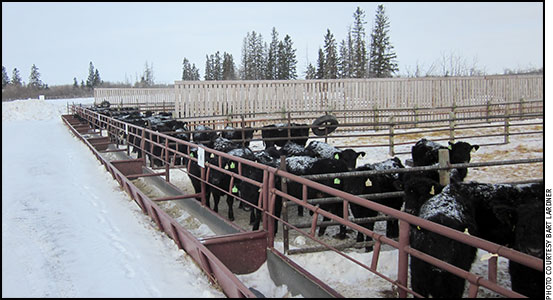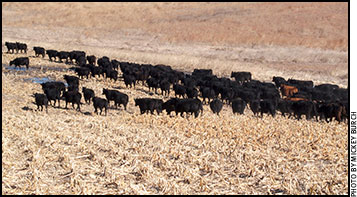
Backgrounding Options
Researcher compares performance of weaned calves between drylot and field-grazing backgrounding systems.
After weaning, there are several programs that can be used to grow calves at a targeted rate of gain and help ensure good productivity and future performance after they enter the feedlot.
Bart Lardner, research scientist at Western Beef Development Center, University of Saskatchewan, says backgrounding aims for a controlled rate of growth, trying to maximize frame size before depositing fat.
“That way we can produce a greater carcass weight at slaughter. It’s all about muscle development and skeletal size for the best potential growth,” he says.
Every animal has a certain growth potential.
“What that ultimate growth can be is controlled by genetics, but the part we can control is environment and nutrition. Most spring-born calves are weaned at 5 to 7 months [of age], and many go into a backgrounding program, depending on the end target,” Lardner explains.
Some light calves are put on a growing ration during winter and then go to grass in the spring for several months.
It all depends on the producer’s situation, and what’s available as feed. “If producers retain calves and plan to background and grow them at a slower rate, they need to have a target end weight in mind. Are they aiming to put on 150 pounds or 200 pounds? What is the target and the market at the end of a backgrounding period? The rate of gain could vary from 1.5 pounds per day to 2 pounds,” says Lardner.
“In a drylot system, we’re looking at gaining 2 pounds per day, or a little more. But in extensive field systems where calves are grazing, we’re looking at between 1.5 to 1.8 pounds per day, knowing these calves won’t get the higher rate of gain you’d see in the drylot system. It’s all about cost effectiveness. You might have to keep them a little longer on grass, but if this is cheaper, it works,” he says.
When the calves get to that 700 to 900 pound (lb.) target — whatever it might be — they will be going into a feedlot. After another 150 to 200 days on feed, they will be at the targeted finish weight of 1,300 lb. He recommends knowing your program and getting planning done before starting it.
“In various programs we’ve looked at, we use our drylot system as a control to compare alternative backgrounding systems that might be an option rather than having to set up feed bunks in a pen with feeding equipment like a tractor and a feedwagon. Some extensive grazing systems work — such as putting 500-pound calves on a swath-graze program.”

cutline
The calves might be able to utilize a cool-season annual like barley or maybe a warm-season annual like millet.
In a three-year study, the performance of backgrounded calves in a drylot system was compared to calves grazing swathed barley or swathed millet.
“We looked at cost of gain — what it cost for every pound put on — in that backgrounding phase. The calves grazing the swathed barley were roughly at 43% less cost of gain compared to our drylot system,” says Lardner.
Lardner also did research on grazing standing corn. This is a typical winter grazing system with pregnant beef cows, but he wanted to know if it would work with weaned calves.
“We compared it to the drylot system and barley swath grazing during a three-year study and saw a little lower rate of gain compared with the drylot. Energy and protein intake was challenged more on cold days out in the field — where calves must try to utilize the whole plant,” he explains.
However, wintering calves on standing corn can be a viable option with proper management.
In the drylot system there were more health issues than in calves wintering in the fields. “We saw some coccidiosis in the drylot calves, but not in the extensive grazing systems,” he says. Those calves seem to be healthier and hardier, especially if they have adequate windbreaks.
In some extensive systems, calves may not be able to consume enough forage to meet targeted rate of gain.
“We had to provide a range pellet — about 5 pounds per head per day. Growing calves need more nutrients than pregnant dry cows that are just trying to maintain body weight,” says Lardner.

Editor’s Note: Heather Smith Thomas is a freelance writer and a cattlewoman from Salmon, Idaho.






